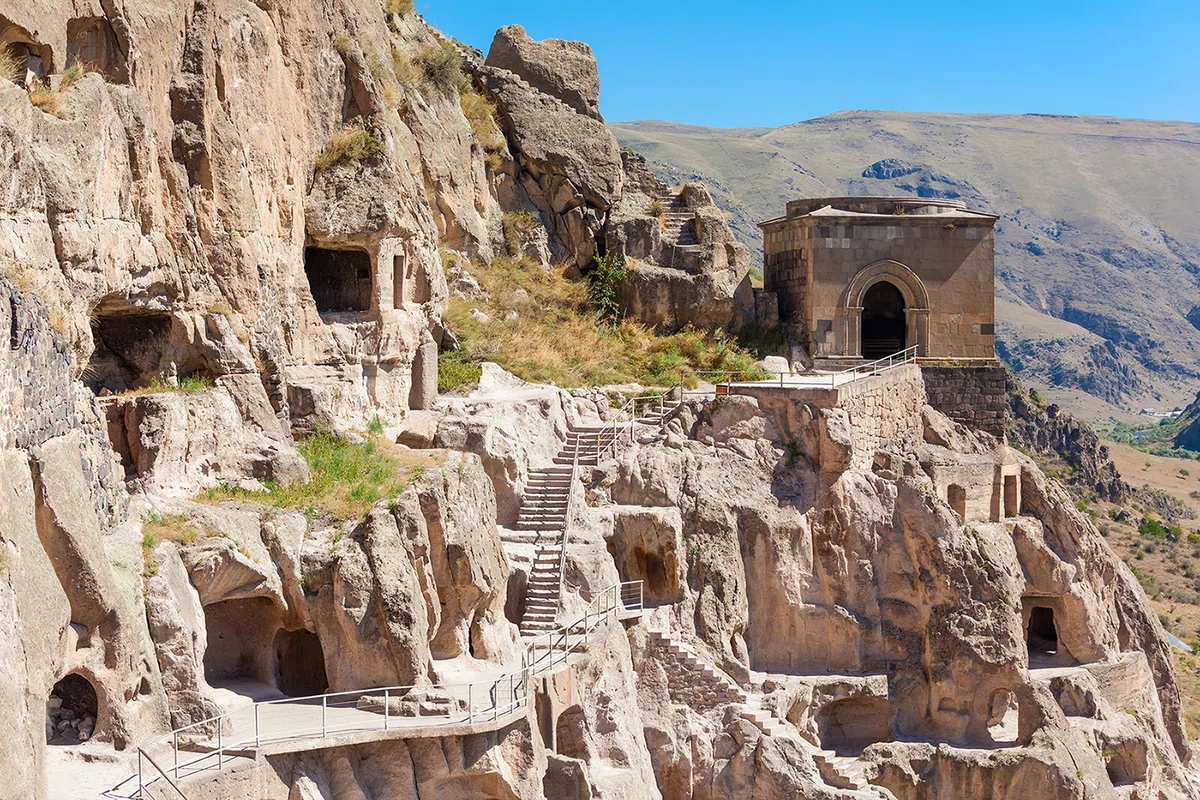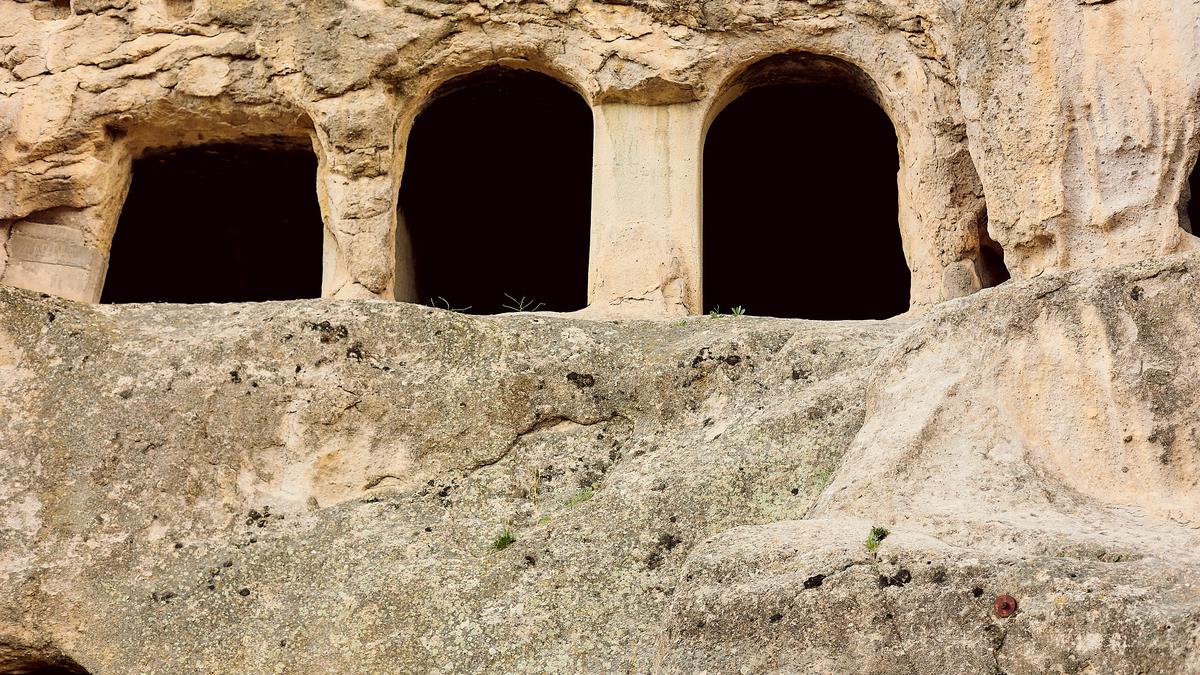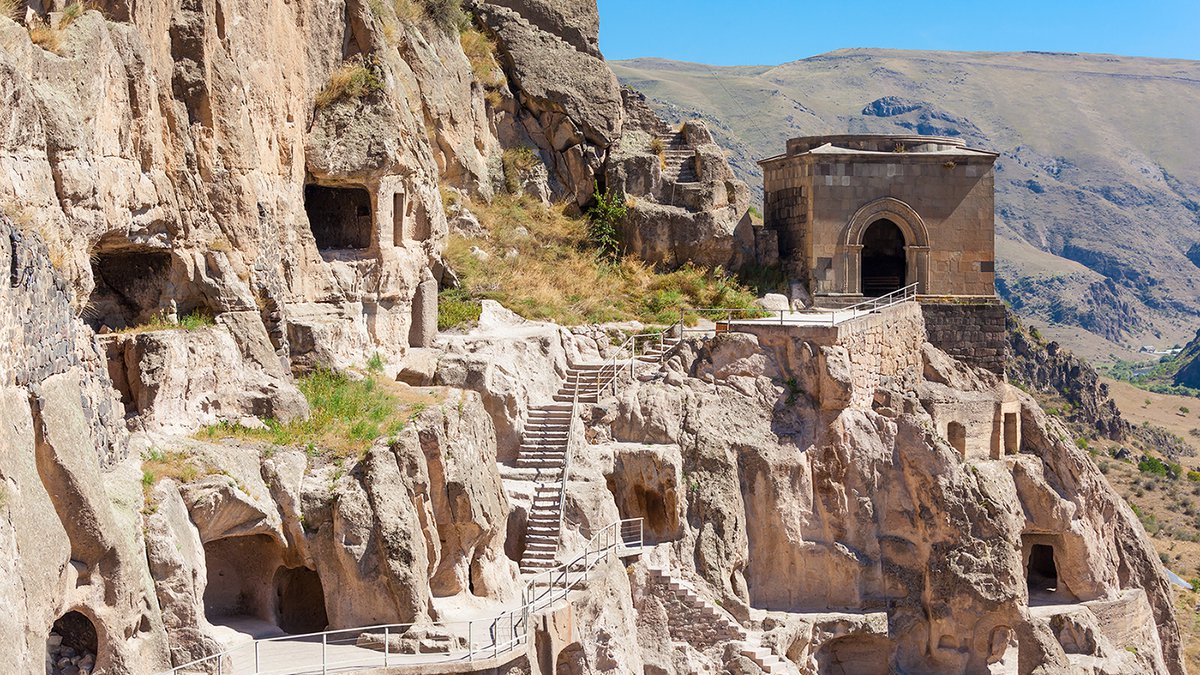
The monastery complex of Vardzia, carved in the rock - the time of creation is the 12th-13th century.
The cave monastery complex of Vardzia is located a hundred kilometers from Borjomi, on the banks of the Kura. About 600 caves of artificial and natural origin can be counted in the complex. The iconic authenticity of Georgia is the Vardzia Cave Complex
The sights of Georgia amaze with their beauty, unique culture and centuries-old history. If you are interested in such a topic as the most interesting places in Georgia, this article is for you. Today we will talk about the ancient monastic city of Vardzia.
Basic
Vardzia is a monastery complex carved into a monolithic mountain high in the mountains, on the eastern branch of the Erusheti ridge, located in Javakheti, on the left bank of the Mtkvari River, at an altitude of 1300 meters above sea level. This town is considered one of the main sights of Georgia.
The highest cave is located at an altitude of 1462 meters above sea level. Towering over the Kura River, Vardzia consists of about 600 caves of artificial and natural origin. The caves deepen by several tens of meters, the rock city has 8 floors in height, the length of the city along the river is about a kilometer.
Carved in the rocks of the monastery Vardzia complex (1156-1203) is located in Javakheti, 30 kilometers from Aspindza, on the left bank of the Kura River.
The activity of John Shavteli took place in Vardzia. The "Song of the Vardzian Theotokos" written by him has been preserved. The leader of the monastery, the manager of affairs, he held at the same time a high position at the royal court - he was the first deputy of the Mtsignobartukhutsi (prime Minister).
In 1551, during the invasion of the Iranian Shah Tahmasp I, an icon of the Mother of God, gold and steel doors and many ornaments were stolen from Vardzia. In 1938, Vardzia received the status of a museum-reserve. At the beginning of the XXI century, monastic life resumed in Vardzia.
The Vardzia Monastery is carved 0.5 km wide . and it is located on 13 floors. It consists of two parts: the rock village of Anauri (X-XII centuries) and the monastery itself. There are 5 stages of the construction of the monastery. At the first stage, during the reign of George III (1156-1184), cells and a church were carved. At the second stage (1184-1185), during the reign of Queen Tamara, there was the Assumption Church of the hall type with a gallery (standing). The temple was painted by the painter George at the expense of eristavi (ruler) Kartli Rati Surameli. At the third stage (1185-1203), the construction of utility rooms and cells, defensive and irrigation structures was completed.
After the earthquake of 1283, Mtavari Samtskhe, Beka Dzhakeli (1285-2306) carried out the IV stage of construction. By his decree, a two-story bell tower decorated with carved ornaments was erected. During the V stage, on the instructions of Atabag Ivan, a large refectory was carved.
In total, the Vardzia consists of 420 rooms. Of these, 25 are marani (wine storage) with 185 kvevri (a large vessel for storing wine). The living cells are two, three and four-room and consist of an entrance hall, a living room and a storage room. The walls of the room are carved with wide niches - as benches, small niches - for dishes, books and lamps. There are 12 chapels in the monastery.
The eastern part of the monastery is best preserved - 242 cave rooms (including a hall with an area of 8x5.6 m), a conference hall, Tamara's room, a recreation room. In the western part of the monastery there is a refectory, and in the central part there are rooms for shelter. The water in the caves came from a natural spring located in the depths behind the main temple (via 3.5 km long water pipes)
. There is a lot of fresco painting in Vardzia. In the Church of the Assumption of the Mother of God of the XII century, the ktitors are depicted: George III, Queen Tamara, Rati Surameli. Here are scenes from the New Testament. The murals of the Ananuri Church date back to the XVI century .
History
The construction of the fortress was started by George III, and his daughter, Queen Tamara, finished it. The original purpose of Vardzia was a fortress, but the queen changed it to a massive fortified monastery. The construction of the Vardzia lasted half a century and ended in 1205 . Vardzia had no artificial fortifications. The fortress wall was a rock, inside of which the monastery city was safely hidden from prying eyes.
In 1551, Vardzia was plundered by the Shah of Iran – Tamaz I, the Persians stole the famous icon of Mary and many other treasures. In 1578, the Turks recaptured Vardzia: many monks were killed, and those who remained alive fled in different directions, and the monastery became uninhabited.
After the establishment of Soviet rule in Georgia, Vardzia was considered a tourist base, and in 1983 a museum was opened. In 1989, with the blessing of the Catholicos-Patriarch of Georgia Ilia II, the divine service was revived, as was the life of the monastery, in 1999.

What you can see in Vardzia:
- Khertvisi Fortress – one of the oldest and best preserved fortresses of the Georgian Middle Ages. Khertvisi is an architectural monument of Georgia. Together with the monastery complex, Vardzia is a candidate for the list of UNESCO World Heritage Sites in Georgia.
- Tmogvi Fortress –medieval fortress, which is located on the banks of the Kura River. From there you can observe the foundations of settlements of ancient Georgians.
- Vanis-Kwabebi – cave monastery in the rocks. It is a quiet, deserted place that has stunning views.








29 comments
Log in to leave a comment
Этот уникальный пещерный комплекс в южной Грузии поражает своей грандиозностью и сложностью. Вардзия была построена в XII веке во времена правления царицы Тамары и служила как монастырь, так и укрепленный город.
Прогуливаясь по этим древним туннелям и залам, невозможно не восхищаться мастерством и упорством тех, кто создал этот удивительный город в скалах. Каждая комната, каждая ниша рассказывают свою историю, и находясь там, чувствуешь себя частью этого далекого прошлого. Вардзия — это место, которое стоит посетить, чтобы ощутить дух древности и прикоснуться к истории Грузии.